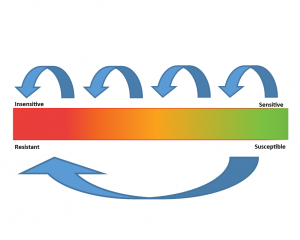Fungicide resistance is an increasingly important issue for Australian agriculture. Resistance of fungal pathogens to fungicides usually becomes a problem following the intensive use of fungicides for disease control. Continued use of a fungicide or fungicide chemical group can result in the selection of specific mutations and in a build-up of resistance within the fungal population even to the point where that particular active or actives from the same group are no longer effective. The risk of fungicide resistance developing varies between the different fungicide groups and different fungal pathogens.
Types of resistance
There are two types of resistance to fungicides.
Multi-step (or continuous or quantitative) resistance is when the pathogen becomes less sensitive to the fungicide over time and gradually higher and higher rates are required to maintain adequate control. In the field this is observed as a gradual decrease in sensitivity to the fungicide with growers having to apply higher and higher levels of fungicide to achieve adequate control. This gradual erosion of the fungicide efficacy is normally due to the accumulation of target site mutations and/or the overexpression of the target. This is currently the case with septoria resistance to tebuconazole.
Disruptive (or discrete or qualitative) resistance is when the pathogen can suddenly tolerate high doses of fungicide and the rates required for adequate control are often impracticable. This is similar to an on/off switch. A fungicide will go from being effective at field rates to ineffective in one shift instead of gradually. This type of resistance is due to the development of target site mutations that have catastrophic effects on the binding of the fungicide to its target. This is the case with wheat powdery mildew resistance to Group 11 (strobilurin) fungicides.

Illustration of multi-step fungicide resistance vs disruptive fungicide resistance. Adapted from Keith J. Brent 2007
Managing Fungicide Resistance
There are a range of strategies that can be used to prevent or delay the development of resistance in fungal populations. These include:
- Implement effective and integrated strategies to control diseases. Reducing or avoiding the need to use fungicides through a range of strategies (i.e. crop rotation, resistant varieties, etc.) will extend their life by maintain low pathogen populations and the number of applications which reduces selection pressure on the pathogen population.
- Rotate your fungicides. Avoid the repeated application of the same active or the same group within the one season. Where possible use actives from different groups or if the same activity group must be applied use a different active within that group. This applies to seed dressing, in furrow and foliar formulations.
- Use fungicides that contain mixtures of more than one active ingredient.
- If resistance is present, or suspected, avoid or minimise use of that mode of action – this will only further select for resistance.
- Test for fungicide resistance. There are a number of places in Australia that can provide fungicide resistance analysis.
- Do not exceed label rates. Use a rate that provides effective disease control.
Registration of Fungicides
Agro-chemicals are constantly being reviewed for safety and efficacy. As new reduced-risk ones come on board some of the older products are deregistered. The federal body involved in the registration and review of pesticides is the Australian Pesticides & Veterinary Medicine Authority (www.apvma.gov.au). The process of registering a product is thorough and requires information on environmental toxicity, safety to users, safety to consumers, fate of chemical breakdown and efficacy.
Licencing and Use of Chemicals
Under the Agricultural and Veterinary Chemicals (Control of Use) Act 1992 any person that uses restricted use chemicals such as S7 Dangerous Poisons must hold appropriate authorisation, such as an Agricultural Chemical Users Permit issued by DEDJTR. This applies to some commonly used fungicides such as carbendazim and procymidone.
All restricted use chemicals must be used in strict accordance with the label, and the user must keep the required records of use of the chemicals.
It is illegal to use unregistered chemicals, and it is also illegal for a grower to sell agricultural produce that contains unacceptable chemical residues.
Off label use of restricted use chemicals in Victoria is not permitted for restricted use chemicals unless a permit has been obtained from the Australian Pesticides and Veterinary Medicines Authority (APVMA).


